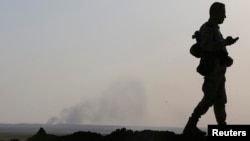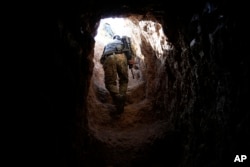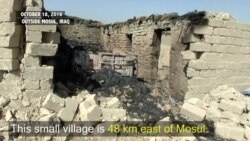Kurdish and Iraqi forces advancing on Mosul are finding a trail of destruction left by the Islamic State (IS) as the two forces retake villages that have been under IS control for more than two years.
“There is complete destruction of infrastructure in those areas; 80 percent of buildings are razed to the ground in some villages,” Kurdish commander Khalil Mustafa said Tuesday, speaking from the front line in Khazir, 48 kilometers (30 miles) northeast of Mosul.
At least 13 villages have been retaken since the offensive began Sunday, according to commanders.
They describe finding miles of trenches and tunnels used by IS members to hide during airstrikes.
“They were using the trenches to move from a house to another without being visible to the planes,” said Hadi Mohammed, a Kurdish fighter in the village of Badana, taken from IS Monday.
The trenches were filled with tires IS intended to set ablaze so the smoke would offer cover from coalition warplanes, Mohammed said. Food, medicine, assorted gear and books were among the items left behind by IS fighters.
“The tires weren’t set on fire probably because IS thugs didn’t have time for that,” Mohammed said as he rummaged through a former IS outpost in the village.
WATCH: Video from village where Kurds drove out IS
‘No sign of life’
Most villagers fled their homes as IS took over the villages in June 2014, meaning IS militants had no so-called “human shields” to deter Iraqi and Kurdish advances, Mustafa, the Kurdish commander, said.
“No sign of life is left in the liberated areas,” said Mustafa, who is leading Kurdish peshmerga. “Most of the destruction has occurred in villages hit by airstrikes targeting IS bases.”
But as forces advance on Mosul, commanders expect stiffer resistance and a more complicated scenario regarding the safety of civilians.
Islamic State militants have reportedly been preventing people from fleeing Mosul and threatening to execute anyone trying to escape in an effort to keep the residents in the city and use them as human shields.
“It’s quite clear Daesh [Islamic State] has started to use civilians as human shields by allowing families to stay in buildings likely to be targeted by airstrikes,” Abu Mahir, who lives near the city’s university, told Reuters. He used an Arabic term for the militants.
Car bombs and booby traps
As Iraqi and Kurdish forces advance, they are also concerned about navigating a trail of IS booby traps and suicide car bombs.
“They have planted explosives everywhere and they use suicide car bombs as the main way of resistance at this point,” Mustafa said. “We’ve changed our tactics against their suicide car bombs. Today, my team destroyed four IS vehicles and killed 20 of the fighters.”
Entering Iraq's second-largest city will be fraught with challenges.
“Mosul is a big city and with a very complicated design of the neighborhoods,” Mustafa said.









